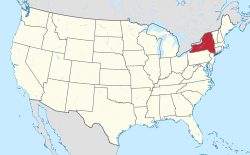Cape Vincent
| Cape Vincent | |
|---|---|
| Town | |
 Location of New York in the United States |
|
| Coordinates: 44°07′40″N 76°20′00″W / 44.12778°N 76.33333°WCoordinates: 44°07′40″N 76°20′00″W / 44.12778°N 76.33333°W | |
| Country | United States |
| State | New York |
| County | Jefferson |
| Government | |
| • Town Supervisor | Debra Suller (R) |
| • Town Council | |
| Area | |
| • Total | 89.78 sq mi (232.53 km2) |
| • Land | 56.28 sq mi (145.76 km2) |
| • Water | 33.50 sq mi (86.77 km2) |
| Population (2010) | |
| • Total | 2,777 |
| • Estimate (2016) | 2,812 |
| • Density | 49.97/sq mi (19.29/km2) |
| Time zone | EST (UTC-5) |
| • Summer (DST) | EDT (UTC-4) |
| ZIP code | 13618 |
| Area code(s) | 315 |
| FIPS code | 36-045-12364 |
Cape Vincent is a town in Jefferson County, New York, United States. The population was 2,777 at the 2010 census.
The Town of Cape Vincent is located in the northwest part of the county. In the town is a village also called Cape Vincent. Both town and village are northwest of Watertown.
The town was first explored in the 17th Century by French explorers and missionaries. At that time it was home to the Onondaga tribe. Modern settlement began in 1801 at Millens Bay.
During the War of 1812, Cape Vincent was an armed camp to oppose the British forces in adjacent Kingston, Ontario.
The town was formed in 1849 from the north part of the Town of Lyme. In 1895, the community of Cape Vincent set itself apart by incorporating as a village. By that time, the region was becoming a famous tourist area due to the Thousand Islands.
In 1935, the East Charity Shoals Light was erected at the entrance to the Seaway.
The Xavier Chevalier House, Nicholas Cocaigne House, Remy Dezengremel House, Joseph Docteur House, James Buckley House, E. K. Burnham House, Reuter Dyer House, East Charity Shoal Light, Johnson House, Captain Louis Peugnet House, George Reynolds House, Rogers Brothers Farmstead, Tibbetts Point Light, Union Meeting House, Claude Vautrin House, and Warren Wilson House are listed on the National Register of Historic Places.
...
Wikipedia
